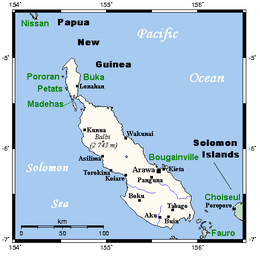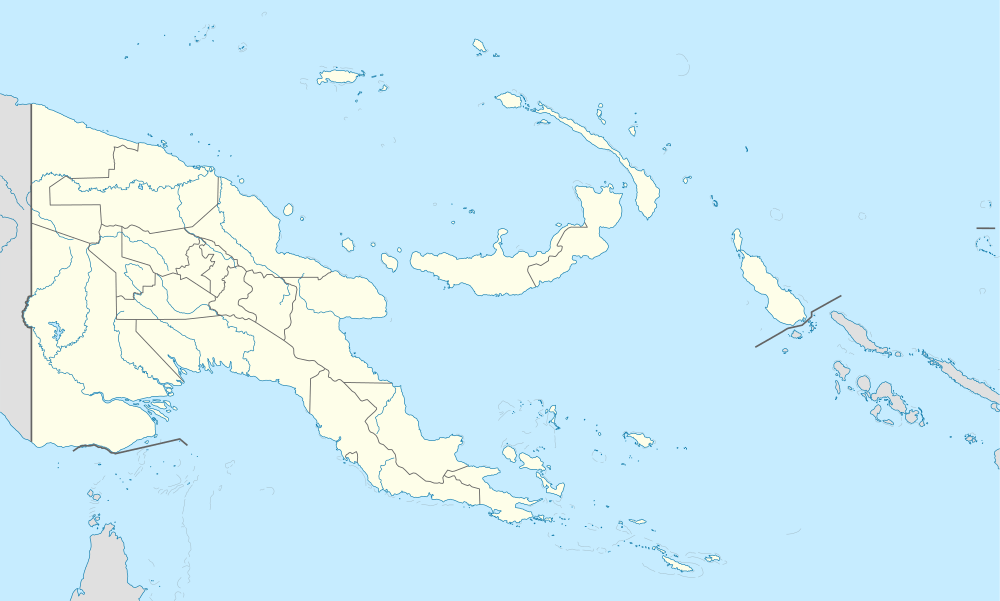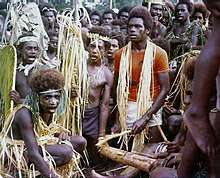Bougainville Island
Bougainville Island (Tok Pisin: Bogenvil)[1] is the main island of the Autonomous Region of Bougainville of Papua New Guinea, also known as Bougainville Province. It formed the main landmass of the German Empire-associated North Solomons. With four to five hundred-metre-width-strait separated Buka Island (c.500 km2) its land measures 9,300 km2 (3591 sq miles). The population of the province is 234,280 (2011 census), which includes islets such as the Carterets. Mount Balbi on the main island at 2,715 m is the highest point. The Buka strait, despite its narrowness, is unbridged; however, regular ferries operate between the key settlements on either side and Buka Town has the main northern airstrip/airport.
 Bougainville and neighbouring islands | |
 Bougainville Bougainville Island (Papua New Guinea) | |
| Geography | |
|---|---|
| Location | Melanesia |
| Coordinates | 6°14′40″S 155°23′02″E |
| Archipelago | Solomon Islands |
| Area | 9,318 km2 (3,598 sq mi) |
| Highest elevation | 2,715 m (8,907 ft) |
| Highest point | Mount Balbi |
| Administration | |
Papua New Guinea | |
| Province | Autonomous Region of Bougainville |
| Demographics | |
| Population | 234,280 (2011) |
| Pop. density | 18.80/km2 (48.69/sq mi) |
| Additional information | |
| Time zone |
|
It is the largest of the Solomon Islands archipelago, most of which, concentrated south and east, are politically independent as the Solomon Islands; from two of these in the close-knit Shortland Islands it is less than 9 km north or north-west to Bougainville; they are in turn about 30 km west of Choiseul, a settlement of which, Poroporo, faces Bougainville.
An outcrop of Buka is 175 kilometres (109 mi) from New Ireland, the next grand island of Papua New Guinea.
History
Bougainville was first settled some 28,000 years ago. Three to four thousand years ago, Austronesian people arrived, bringing with them domesticated pigs, chickens, dogs, and obsidian tools. The first European contact with Bougainville was in 1768, when the French explorer Louis Antoine de Bougainville arrived and named the main island for himself.
British and American whaling ships visited the island for provisions, water and wood in the 19th century. The first on record was the Roscoe in 1822, and the last was Palmetto in 1881.[2]
The German Empire laid claim to Bougainville in 1899, annexing it into German New Guinea. Christian missionaries arrived on the island in 1902.

During World War I, Australia occupied German New Guinea, including Bougainville. It became part of the Australian Territory of New Guinea under a League of Nations mandate in 1920.
In 1942, during World War II, Japan invaded the island, but allied forces launched the Bougainville campaign to regain control of the island in 1943.[3][4] Despite heavy bombardments, the Japanese garrisons remained on the island until 1945. Following the war, the Territory of New Guinea, including Bougainville, returned to Australian control.
In 1949, the Territory of New Guinea, including Bougainville, merged with the Australian Territory of Papua, forming the Territory of Papua and New Guinea, a United Nations Trust Territory under Australian administration.
On 9 September 1975, the Parliament of Australia passed the Papua New Guinea Independence Act 1975. The Act set 16 September 1975 as date of independence and terminated all remaining sovereign and legislative powers of Australia over the territory. Bougainville was to become part of an independent Papua New Guinea. However, on 11 September 1975, in a failed bid for self-determination, Bougainville declared itself the Republic of the North Solomons. The republic failed to achieve any international recognition, and a settlement was reached in August 1976. Bougainville was then absorbed politically into Papua New Guinea with increased self-governance powers.
Between 1988 and 1998, the Bougainville Civil War claimed over 15,000 lives. Peace talks brokered by New Zealand began in 1997 and led to autonomy. A multinational Peace Monitoring Group (PMG) under Australian leadership was deployed. In 2001, a peace agreement was signed including promise of a referendum on independence from Papua New Guinea. This referendum was held between 23 November and 7 December 2019, with results being declared on 11 December.[5] The referendum question was a choice between greater autonomy within Papua New Guinea, or full independence. Of the valid votes, 98.31% were in favour of full Independence. The vote is not binding; the Government of Papua New Guinea has the final say on the status of Bougainville.[6][7]
Geography
Bougainville is the largest island in the Solomon Islands archipelago. It is part of the Solomon Islands rain forests ecoregion. Bougainville and the nearby island of Buka are a single landmass separated by a deep 300-metre-wide strait. The island has an area of 9000 square kilometres, and there are several active, dormant or inactive volcanoes which rise to 2400 m. Bagana (1750 m) in the north central part of Bougainville is conspicuously active, spewing out smoke that is visible for many kilometres. Earthquakes are frequent, but cause little damage.
 Bagana volcano
Bagana volcano Northern part of the island
Northern part of the island
Ecology
Bougainville Island is primarily forested with a diverse tropical ecosystem. Copper mining on the island by a Rio-Tinto owned mining operation caused significant detriment to the immediate and downstream ecology from the destruction of forest and heavy metal contaminated mine tailings, resulting in an uprising by the islanders to protect their land and native ecology.[8] More recently, deforestation in order to feed the growing population has affected the flow of many rivers on the island.[9] The United Nations Environmental Program has offered to facilitate the clean up of the Rio Tinto owned Panguna mine and explore reopening the mine with more stringent environmental standards.[10]
Climate
| Climate data for Bougainville | |||||||||||||
|---|---|---|---|---|---|---|---|---|---|---|---|---|---|
| Month | Jan | Feb | Mar | Apr | May | Jun | Jul | Aug | Sep | Oct | Nov | Dec | Year |
| Average high °C (°F) | 32 (89) |
32 (89) |
31 (88) |
31 (87) |
31 (87) |
31 (87) |
30 (86) |
31 (87) |
31 (87) |
30 (86) |
31 (88) |
31 (88) |
31 (87) |
| Average low °C (°F) | 22 (72) |
22 (71) |
23 (73) |
22 (72) |
22 (71) |
22 (71) |
22 (71) |
22 (71) |
22 (71) |
22 (71) |
22 (72) |
23 (73) |
22 (72) |
| Average precipitation mm (inches) | 560 (22.2) |
190 (7.5) |
370 (14.7) |
290 (11.4) |
280 (11.1) |
240 (9.5) |
510 (19.9) |
320 (12.7) |
350 (13.9) |
580 (22.9) |
420 (16.4) |
490 (19.2) |
4,610 (181.4) |
| Source: Weatherbase[11] | |||||||||||||
Economy
Bougainville has one of the world's largest copper deposits, which has been under development since 1972, but was shut down in a popular revolution against the foreign-owned mining interests.[8] Due to a 7-year blockade of the island by the Papua New Guinean Army during the Coconut Revolution, the island was cut off from the outside world. This pressure forced the islanders to develop self-sustaining systems from salvaged parts and foraged resources, including village-scale hydropower, coconut bio-diesel, diversified forest-garden farms, and neo-traditional herbal medicine.[12] These ingenious innovations were a major focus of the documentary film The Coconut Revolution. [13]
Demographics
Religion
The majority of people on Bougainville are Christian, an estimated 70% being Roman Catholic and a substantial minority United Church of Papua New Guinea since 1968. Few non-natives remain as most were evacuated following the civil wars.
Languages
There are many indigenous languages in Bougainville Province, belonging to three language families. The languages of the northern end of the island, and some scattered around the coast, belong to the Austronesian family. The languages of the north-central and southern lobes of Bougainville Island belong to the North and South Bougainville families.

The most widely spoken Austronesian language is Halia and its dialects, spoken in the island of Buka and the Selau peninsula of Northern Bougainville. Other Austronesian languages include Nehan, Petats, Solos, Saposa (Taiof), Hahon and Tinputz, all spoken in the northern quarter of Bougainville, Buka and surrounding islands. These languages are closely related. Bannoni and Torau are Austronesian languages not closely related to the former, which are spoken in the coastal areas of central and south Bougainville. On the nearby Takuu Atoll a Polynesian language is spoken, Takuu.[14]
The Papuan languages are confined to the main island of Bougainville. These include Rotokas, a language with a very small inventory of phonemes, Eivo, Terei, Keriaka, Naasioi (Kieta), Nagovisi, Siwai (Motuna), Baitsi (sometimes considered a dialect of Siwai), Uisai and several others. These constitute two language families, North Bougainville and South Bougainville.
None of the languages are spoken by more than 20% of the population, and the larger languages such as Nasioi, Korokoro Motuna, Telei, and Halia are split into dialects that are not always mutually understandable. For general communication most Bougainvilleans use Tok Pisin as a lingua franca, and at least in the coastal areas Tok Pisin is often learned by children in a bilingual environment. English and Tok Pisin are the languages of official business and government.
Human rights
Cut off from the outside world for several years by a Papua New Guinean blockade during the Coconut Revolution, the islanders suffered many deaths from a lack of medical resources.[15]
A 2013 United Nations survey of 843 men found that 62% (530 respondents) of those have raped a woman or girl at least once, with 41% (217 respondents) of the men reported having raped a non-partner, whereas 14% (74 respondents) reported having committed gang rape. Additionally, the survey also found that 8% (67 respondents) of the men had raped other men or boys.[16]
Popular culture
The Coconut Revolution, a documentary about the struggle of the indigenous population to save their island from environmental destruction and gain independence, was made in 1999.[8]
An Evergreen Island (2000), a film by Australian documentary filmmakers Amanda King and Fabio Cavadini of Frontyard Films, showed the ingenuity with which the Bougainvillean people survived for almost a decade (1989-1997) without trade or contact with the outside world, because of a trade dispute.[17][18][19]
Mr. Pip (2012) is a film by New Zealand director Andrew Adamson based on the book Mister Pip by Lloyd Jones.
Independence referendum
In late November 2019 a non-binding referendum was held to decide whether Bougainville should be a sovereign state independent from Papua New Guinea. The result was overwhelmingly in favour of sovereignty for the island, with 98% of the votes supporting secession.[20]
See also
References
- "Bogenvil". Tok Pisin English Dictionary. Retrieved 4 December 2019.
- Langdon, Robert (1984), Where the whalers went: an index to the Pacific Ports and islands visited by American whalers (and some other ships) in the 19th century, Canberra, Pacific Manuscripts Bureau, p.184-5. ISBN 086784471X
- Hall, R. Cargill (1991). Lightning Over Bougainville: The Yamamoto Mission Reconsidered. Smithsonian Institution Press. ISBN 1-56098-012-5.
- Gailey, Harry A. (1991). Bougainville, 1943–1945: The Forgotten Campaign. University Press of Kentucky. ISBN 0-8131-1748-8.
- "Bougainville set to hold long-awaited independence referendum". France 24. 27 September 2019. Retrieved 6 October 2019.
- "Bougainville referendum not binding - PM". Radio New Zealand. 11 March 2019. Retrieved 18 March 2019.
- "Bougainville referendum: region votes overwhelmingly for independence from Papua New Guinea". The Guardian. Retrieved 11 December 2019.
- "Coconut Revolution, The (Bougainville story)".
- "Water crisis looms from deforestation; alluvial mining". Bougainville 24 – BCL news blog. Archived from the original on 4 March 2016. Retrieved 8 January 2016.
- "UNEP to help Bougainville manage clean-up of Rio Tinto mine". ABC News.
- "Weatherbase: Historical Weather for Bougainville, Papua New Guinea". Weatherbase. 2011. Retrieved on 24 November 2011.
- "Coconut Revolution, The (Bougainville story)".
- "Coconut Revolution, The (Bougainville story)".
- Irwin, H. (1980). Takuu Dictionary. : A Polynesian language of the South Pacific. Canberra: Pacific Linguistics. 428pp. ISBN 978-0858836372.
- "Coconut Revolution, The (Bougainville story)".
- "Why do some men use violence against women and how can we prevent it" (PDF). Archived from the original (PDF) on 4 March 2016.
- "An Evergreen Island". National Film and Sound Archive. Retrieved 19 January 2015.
- "Bougainville film shows courage and community". Green Left Weekly. 26 July 2000. Retrieved 19 January 2014.
- "An Evergreen Island". New Internationalist.
- Bougainville, PNG correspondent Natalie Whiting in (14 December 2019). "The remote, impoverished island sitting on a multi-billion-dollar gold mine". ABC News. Retrieved 15 December 2019.
Bibliography
- Hall, R. Cargill (1991). Lightning Over Bougainville: The Yamamoto Mission Reconsidered. Smithsonian Institution Press. ISBN 1-56098-012-5.
- Gailey, Harry A. (1991). Bougainville, 1943–1945: The Forgotten Campaign. University Press of Kentucky. ISBN 0-8131-1748-8.
- Hobbs, J. (2017). Fundamentals of World Regional Geography (4th ed.). Boston, Massachusetts.
Further reading
| Wikimedia Commons has media related to Bougainville Island. |
| Wikivoyage has a travel guide for Bougainville. |
- Robert Young Pelton, Hunter Hammer and Heaven, Journeys to Three Worlds Gone Mad. ISBN 1-58574-416-6